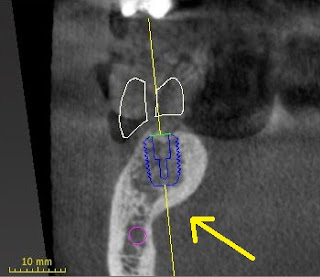This latest blog will continue our discussion of using the latest CT digital imaging to plan and place dental implants. Today's implant placement software allows us to not only see if an implant can be placed prior to surgery, but after placing a digital implant in the software, we can translate that information to your actual mouth and have the implant placed precisely where it was in the software. This removes almost all risk in implant placement error. We also are excited to offer immediate implant placement following the same protocols. Frequently patients come in on emergency with fractured or decayed teeth that cannot be restored and unfortunately have to be removed. Immediate implants are dental implants placed the same day as taking the tooth out. This dramatically cuts down on healing time and can decrease overall costs. Prior to tooth removal, we can scan the mouth, digitally plan the case and have a custom guide fabricated for the day of surgery. Statistically there is little difference in success rates of immediate vs. delayed implant placement as long as you follow strict protocols and proper surgical technique! Here is an image of the treatment planning software with an implant placed in a healed site:
As you can see, I even custom fabricated a digital tooth, so I can place the implant in the best possible position to support the future crown.
This is what separates our surgical techniques from other offices whom may place implants freehand with out any CT data or guide. Our whole process and planning is based off the end result, a functional and aesthetic tooth.
By using precision guided placement, a surgical guide stent is fabricated with a sleeve that only allows placement in the location that was predetermined in the implant planning software. It is so accurate that the even the depth is predetermined and built into this surgical guide.
The implant placement is extremely predictable and rarely is there discomfort, especially if an implant is placed in a healed site. Here is an image of an implant placed using the above guide on the day of surgery with a custom healing cap:

After four to six months of healing, an impression is taken of the implant, and a custom abutment and crown are placed. This new crown will function and feel like a natural tooth without the possibility of ever getting a cavity.
For more information, please visit our website: www.crowfamilydental.com
















